It looks like you're using an Ad Blocker.
Please white-list or disable AboveTopSecret.com in your ad-blocking tool.
Thank you.
Some features of ATS will be disabled while you continue to use an ad-blocker.
share:
Within the last week it appears that at least four asteroids were "discovered", and passed earth at their closest point and all four of these
asteroids passed closer than asteroid 2007 Tu24 ever did.
I am certainly no expert but if these asteroids are being discovered right before they are on top of earth that is a little unnerving. I know that this is probably normal, but I have been watching this stuff for alittle while and this appears to be a "pack" or group of them. Can someone tell me if this is really normal? Here is some background information:
1AU=approximately 149,598,000 km
1AU=approximately 92,955,888 miles
Tu24 closest point= .0037AU
Tu24 closest point(in miles)=343,936 miles
Distance of moon from earth=between 221,463 miles to 251,968 miles +/-
Here are the 'roids:
2008 ED8
"Discovered" 3/10, closest point to earth 3/10?
Closest point= .0035AU=325,345miles
Link to NASA JPL orbital diagram
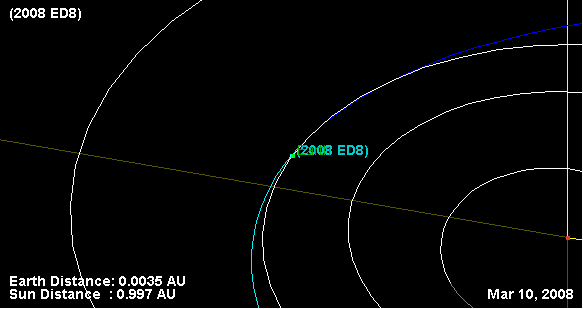
2008 EM68
"Discovered" 3/8, closest point to earth 3/10?
Closest point= .0014AU=130,138 miles
Link to NASA JPL Orbital diagram
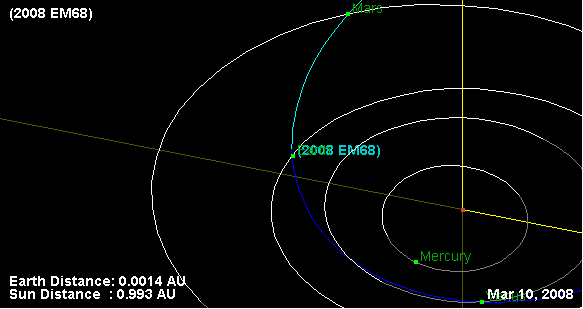
2008 EZ7
"Discovered" 3/7, closest point to earth 3/9?
Closest point= .0011AU=102,251 miles
Link to NASA JPL orbital diagram
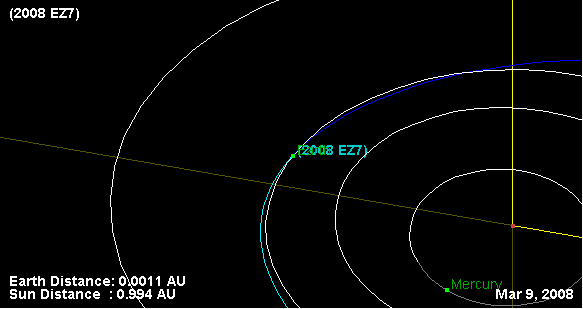
2008 EF32
"Discovered" 3/11, closest point to earth 3/10?
Closest point= .0005AU=46,477 miles
Link to NASA JPL orbital diagram
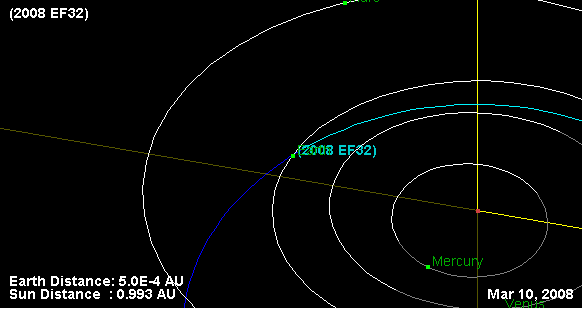
You can also find more on these here (Tom's/Harvard asteroid flyby info):
hea-www.harvard.edu...
And you can also see if these affected the magnetosphere here:
www2.nict.go.jp...
Does this worry anyone? There was also at least one other asteroid during the period above but it was not closer than Tu24. Later.
I am certainly no expert but if these asteroids are being discovered right before they are on top of earth that is a little unnerving. I know that this is probably normal, but I have been watching this stuff for alittle while and this appears to be a "pack" or group of them. Can someone tell me if this is really normal? Here is some background information:
1AU=approximately 149,598,000 km
1AU=approximately 92,955,888 miles
Tu24 closest point= .0037AU
Tu24 closest point(in miles)=343,936 miles
Distance of moon from earth=between 221,463 miles to 251,968 miles +/-
Here are the 'roids:
2008 ED8
"Discovered" 3/10, closest point to earth 3/10?
Closest point= .0035AU=325,345miles
Link to NASA JPL orbital diagram

2008 EM68
"Discovered" 3/8, closest point to earth 3/10?
Closest point= .0014AU=130,138 miles
Link to NASA JPL Orbital diagram

2008 EZ7
"Discovered" 3/7, closest point to earth 3/9?
Closest point= .0011AU=102,251 miles
Link to NASA JPL orbital diagram

2008 EF32
"Discovered" 3/11, closest point to earth 3/10?
Closest point= .0005AU=46,477 miles
Link to NASA JPL orbital diagram

You can also find more on these here (Tom's/Harvard asteroid flyby info):
hea-www.harvard.edu...
And you can also see if these affected the magnetosphere here:
www2.nict.go.jp...
Does this worry anyone? There was also at least one other asteroid during the period above but it was not closer than Tu24. Later.
Well that really is an eye-opener....
And quite un-nerving
Good work
Cheers
Mungo
And quite un-nerving
Good work
Cheers
Mungo
reply to post by Terrapop
Well according to the Tom's asteroid flyby/Harvard.edu page none of the four were classified as "potentially hazarous". This page does not give a size but on the page it is says the "H" variable is absolute magnitude which kind of means that "smaller is brighter/bigger". These four range from 29.4-27.5 while Tu24 was 20.6. Maybe that helped?
I am not necessarily as interested in the size but rather the late "discovery" before the closest point to earth and also the number of them. It just looks like there are more asteroids popping up right in our face than in the past, but I have only been following this stuff for a few months. I'm looking for some insight I guess.
Well according to the Tom's asteroid flyby/Harvard.edu page none of the four were classified as "potentially hazarous". This page does not give a size but on the page it is says the "H" variable is absolute magnitude which kind of means that "smaller is brighter/bigger". These four range from 29.4-27.5 while Tu24 was 20.6. Maybe that helped?
I am not necessarily as interested in the size but rather the late "discovery" before the closest point to earth and also the number of them. It just looks like there are more asteroids popping up right in our face than in the past, but I have only been following this stuff for a few months. I'm looking for some insight I guess.
This time of year, and part of space the Earth is passing through seems to be littered with large/medium sized chunks of rock. There have also been
numerous fireballs/bolides in the last few weeks/months, many of which I have posted about if you check back over this forum. It's not *that* out of
the ordinary though. We are just getting better at spotting them.
Originally posted by Terrapop
How large are these objects?
To answer your question....
2008 ED8 - Est. Diameter 42 m - 95 m
2008 EM68 - Est. Diameter 7.8 m - 18 m
2008 EZ7 - Est. Diameter 10 m - 23 m
2008 EF32 - Est. Diameter 3.5 m - 7.8 m
Compared to
2007 TU24 - Est. Diameter of 250m, these are all much, much smaller, but closer to the earth than TU24 was, as had been pointed out. Nice info, BTW!
Brightness decreases at the inverse square of the distance. It's not at all surprising that small objects like this aren't noticed until they are
very close.
[edit on 13-3-2008 by nataylor]
[edit on 13-3-2008 by nataylor]
reply to post by C.H.U.D.
Hi Chud. Well, I think we have disagreed on this before but IMO, there is a slight increase in these fireballs/bollides recently. But hey, as long as they burn up before they get here, I'm happy.
Check out this latest one from Canada on March 5:
Meteor Videotaped Plunging to Earth
~source~
Hi Chud. Well, I think we have disagreed on this before but IMO, there is a slight increase in these fireballs/bollides recently. But hey, as long as they burn up before they get here, I'm happy.
Check out this latest one from Canada on March 5:
Meteor Videotaped Plunging to Earth
But on the evening of March 5 (at 10:59 p.m. EST, to be exact), the University of Western Ontario's network of all-sky cameras captured video of a large fireball, said university researcher Peter Brown.
"Most meteoroids burn up by the time they hit an altitude of 60 or 70 kilometers [37 or 43 miles] from Earth," said Edwards. "We tracked this one to an altitude of about 24 kilometers [15 miles] so we are pretty sure there are at least one, and possibly many, meteorites that made it to the ground."
~source~
this could of been very messy
im sure if thos objects that size hit it could of completly destroyed a major city
im sure if thos objects that size hit it could of completly destroyed a major city
Problem is, these things are so small that they're quite difficult to detect. Sometimes they find them after they cross the Earth's orbit,
missing us by just a few hours (meaning the asteroid crosses Earth's orbit where the Earth was a few hours ago).
It does happen regularly and it would be almost impossible to have a detection grid that would get them all.
It does happen regularly and it would be almost impossible to have a detection grid that would get them all.
Its the one they dont see coming that worries me,
It also worries me that all these close calls are a sign of whats to come, i saw a documentary years ago in Uni that showed collisions in the steroid belt, and how these collisions cause meteors to come our way, but it also showed that the collisions send out faster smaller chunks in the same direction,
Im not to sure about the theory behind it i guess it is like playing pool and balls moving at different speeds in the same direction line them up and strike them with the white ball, and they all go away at different speeds, nearest the slowest furthest the quickest,
just my brain trying to restart.
It also worries me that all these close calls are a sign of whats to come, i saw a documentary years ago in Uni that showed collisions in the steroid belt, and how these collisions cause meteors to come our way, but it also showed that the collisions send out faster smaller chunks in the same direction,
Im not to sure about the theory behind it i guess it is like playing pool and balls moving at different speeds in the same direction line them up and strike them with the white ball, and they all go away at different speeds, nearest the slowest furthest the quickest,
just my brain trying to restart.
The daily numbers are astounding. On one day alone there were 943 potential hazards. I did some research for the TU24 and found that the number of
them has increased drastically. The increase in the numbers is so mind boggling, I just stop worrying about it. I don’t know which is worse the
coronal hole or the number of asteroids floating by us.
www.spaceweather.com...
List
cfa-www.harvard.edu...
Near-Earth Asteroids
Potentially Hazardous Asteroids (PHAs) are space rocks larger than approximately 100m that can come closer to Earth than 0.05 AU. None of the known PHAs is on a collision course with our planet, although astronomers are finding new ones all the time. [comment]
On March 14, 2008 there were 943 potentially hazardous asteroids.
March 2008 Earth-asteroid encounters:
Asteroid Date(UT) Miss Distance Mag. Size
2008 DH5 Mar. 5 7.1 LD 18 60 m
2008 EZ7 Mar. 9 0.4 LD 18 18 m
2008 ED8 Mar. 10 1.4 LD 12 64 m
1620 Geographos Mar. 17 49 LD 13 3 km
2003 FY6 Mar. 21 6.3 LD 15 145 m
Notes: LD means "Lunar Distance." 1 LD = 384,401 km, the distance between Earth and the Moon. 1 LD also equals 0.00256 AU. MAG is the visual magnitude of the asteroid on the date of closest approach.
www.spaceweather.com...
List
cfa-www.harvard.edu...
That Peruvian Meteorite that smashed into the High mountains and created that water filled crater, surprised scientists as it exibited new behavior
never theorized before.
In other words a very small stoney meteor that should have burned up in the atmosphere didn't burn up due to a sheathing effect of the plasma like gasses released during its short decent. (sort of like a heat shield)
see www.abovetopsecret.com...
bottom line - a high angle of incidence may not allow time for the meteor to burn up before it turns you into a lake.
In other words a very small stoney meteor that should have burned up in the atmosphere didn't burn up due to a sheathing effect of the plasma like gasses released during its short decent. (sort of like a heat shield)
see www.abovetopsecret.com...
bottom line - a high angle of incidence may not allow time for the meteor to burn up before it turns you into a lake.
Originally posted by hsur2112
Hi Chud. Well, I think we have disagreed on this before but IMO, there is a slight increase in these fireballs/bollides recently. But hey, as long as they burn up before they get here, I'm happy.
Check out this latest one from Canada on March 5:
hsur,
Sure, its been a busy couple of months as far as bolides are concerned. These events are random, so no two years will be alike. This time last year was not quite as busy, but is still more than within the realms of what can be expected. Previous years before last have been just as busy as this in my recollection, but obviously you know better than someone who has been observing meteors, and part of the meteor observing community for nearly a decade
By the way, if you check a few posts down in this forum, you'll see that I'm well aware of the Ontario fireball
Originally posted by Siren
The daily numbers are astounding. On one day alone there were 943 potential hazards.
That number is the total number of known PHOs. They did not all fly by us in one day if that's what you were implying Siren
Originally posted by Eagle1229
That Peruvian Meteorite that smashed into the High mountains and created that water filled crater, surprised scientists as it exhibited new behavior never theorized before.
In other words a very small stoney meteor that should have burned up in the atmosphere didn't burn up due to a sheathing effect of the plasma like gases released during its short decent. (sort of like a heat shield)
Meteors are an area of science where we still have lots to learn - many things about them are poorly understood, such as persistent trains and electrophonic phenomena. The behavior you describe above is certainly unusual in the sense that no one has observed it before, but we shouldn't be surprised that new discoveries are being made in this field. It sounds like quite a rare occurrence, and not something to worry about too much IMHO.
I think you misunderstood what the mechanism of this phenomena was. As far as I understand it, what they are saying is that the meteor broke up, and the leading piece acted as the shield, protecting the piece behind it from ablation. Your link also suggests that the meteor may have become unusually streamlined during this process, thus helping it survive the remainder of its luminous flight.
Still - nice find
Originally posted by Eagle1229
bottom line - a high angle of incidence may not allow time for the meteor to burn up before it turns you into a lake.
Correct - Only when the angle is between 2 and 4 degrees and if the initial velocity is below 30km/s will a meteor be able to survive the fall to ground. Of course this does not apply to large/asteroid sized objects!
Edit for typo
[edit on 14-3-2008 by C.H.U.D.]
It took awhile yesterday but there were also three other asteroids that came close around the same time but not as close as Tu24. I'll include them
below just to give the whole picture of the recent activity.
2008 EC32
"discovered" 3/10, closest point to earth 3/7?
Closest point= .0051AU = 474,075 miles
Link to NASA JPL orbital diagram for 2008 EC32
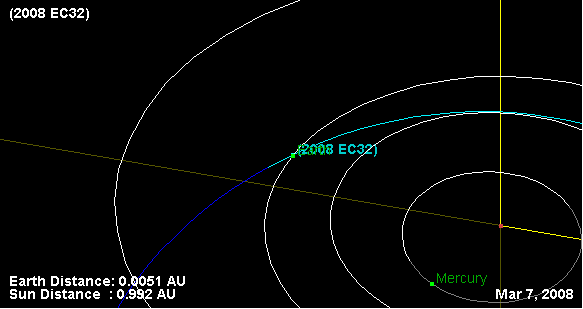
2008 EG32
"discovered" 3/11, closest point to earth 3/9
Closest point= .0078AU = 752,055 miles
Link to NASA JPL orbital diagram for 2008 EG32
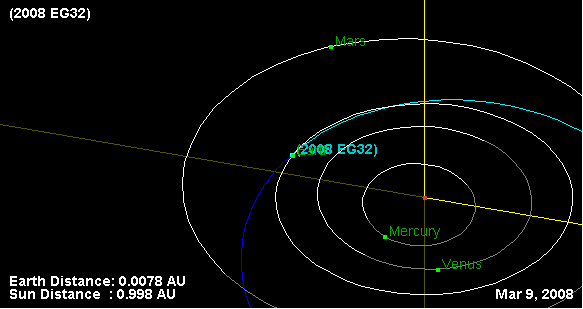
2008 DU22
"discovered" 2/28, closest point to earth 3/2
Link to NASA JPL orbital diagram for 2008 DU22
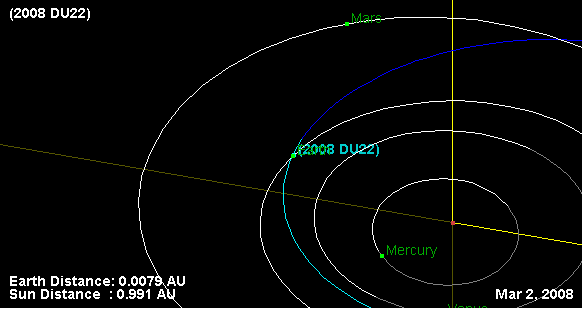
Also, I was looking at the "Space Weather Simulation" website again and comparing the graphs for the day that some of the asteroids I posted above (and in my original post) and noticed some differences. To me if you compare the graphs from yesterday ("calm" day) with the graphs from 3/9/08 ("busy" day) you can see a big difference. Can this be explained by the presence of asteroids within "close" proximity to earth? What are the other factors that affect the graphs (i.e. sun activity,etc.).
Here is the home page for the site I referenced above:
Space Weather Simulation website
Here are the graphs I am talking about:
"Plasma Temperature and Density at Geostationary Orbit and AE Index"
3/9/08 ("busy" day)
Link to graphs for 3/9/08
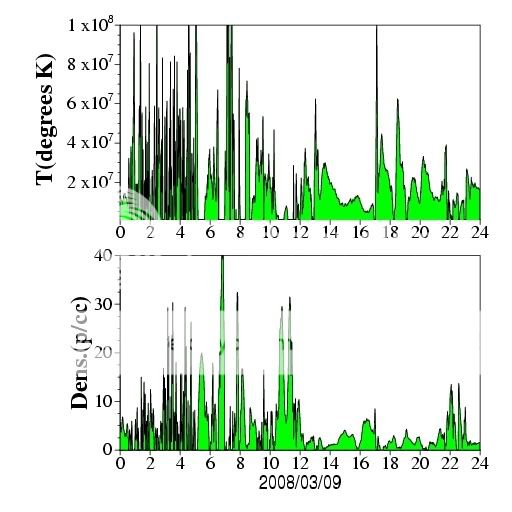
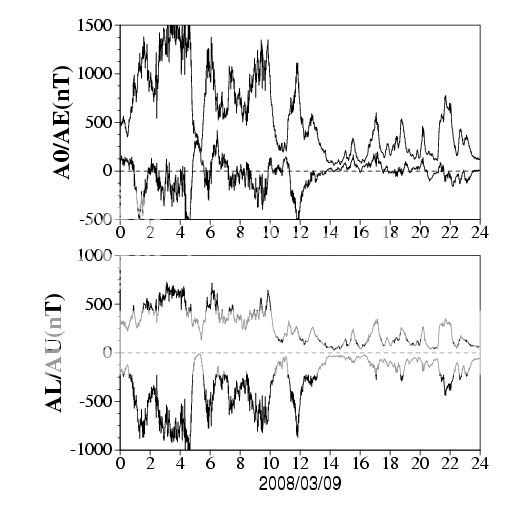
3/13/08 (non "busy" day)
Link to graphs for 3/13/08
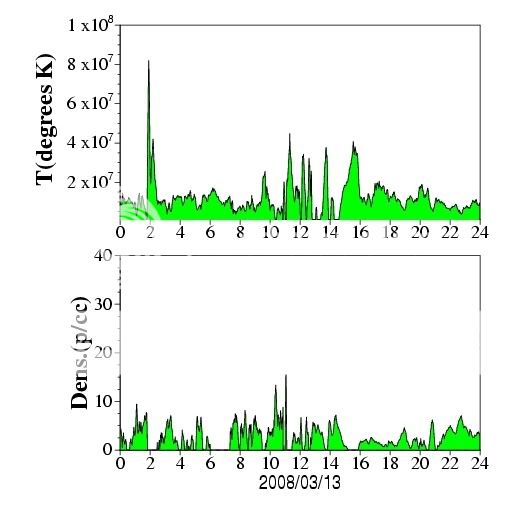
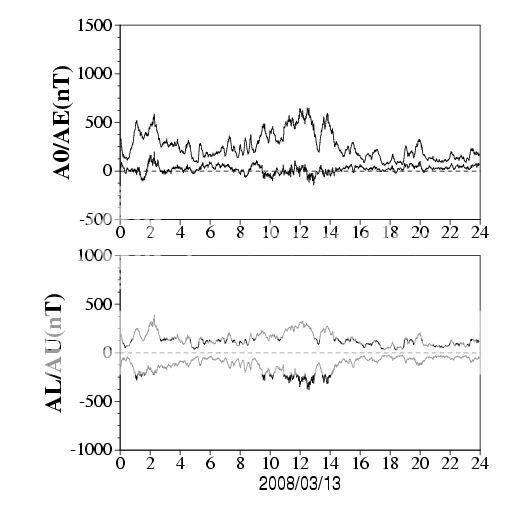
Obviously you can see the difference, but can this be because of the asteroids? What if a large quantity of asteroids pass though at once? Could a future large quantity of asteroids that pass near earth at one time be more worrisome than a single asteroid actually hitting the earth? I just want to know if there is a limit to what this "area" can take before we on the surface notice something. Thanks for reading.
2008 EC32
"discovered" 3/10, closest point to earth 3/7?
Closest point= .0051AU = 474,075 miles
Link to NASA JPL orbital diagram for 2008 EC32

2008 EG32
"discovered" 3/11, closest point to earth 3/9
Closest point= .0078AU = 752,055 miles
Link to NASA JPL orbital diagram for 2008 EG32

2008 DU22
"discovered" 2/28, closest point to earth 3/2
Link to NASA JPL orbital diagram for 2008 DU22

Also, I was looking at the "Space Weather Simulation" website again and comparing the graphs for the day that some of the asteroids I posted above (and in my original post) and noticed some differences. To me if you compare the graphs from yesterday ("calm" day) with the graphs from 3/9/08 ("busy" day) you can see a big difference. Can this be explained by the presence of asteroids within "close" proximity to earth? What are the other factors that affect the graphs (i.e. sun activity,etc.).
Here is the home page for the site I referenced above:
Space Weather Simulation website
Here are the graphs I am talking about:
"Plasma Temperature and Density at Geostationary Orbit and AE Index"
3/9/08 ("busy" day)
Link to graphs for 3/9/08


3/13/08 (non "busy" day)
Link to graphs for 3/13/08


Obviously you can see the difference, but can this be because of the asteroids? What if a large quantity of asteroids pass though at once? Could a future large quantity of asteroids that pass near earth at one time be more worrisome than a single asteroid actually hitting the earth? I just want to know if there is a limit to what this "area" can take before we on the surface notice something. Thanks for reading.
Originally posted by C.H.U.D.
Originally posted by hsur2112
Hi Chud. Well, I think we have disagreed on this before but IMO, there is a slight increase in these fireballs/bollides recently. But hey, as long as they burn up before they get here, I'm happy.
Check out this latest one from Canada on March 5:
Previous years before last have been just as busy as this in my recollection, but obviously you know better than someone who has been observing meteors, and part of the meteor observing community for nearly a decade
By the way, if you check a few posts down in this forum, you'll see that I'm well aware of the Ontario fireball
Actually my friend, no...I do not claim to know more than you or anyone out there about this subject. I've been watching the skies for over 4 decades, crap, did I just give away my age, so I was once again just stating a personal opinion/observation.
At the time I posted my reply I had not seen your thread, didn't mean to step on your toes there or hurt any feelings. Maybe there were others reading this thread whom haven't seen it as well.
reply to post by Moserious
As to the first part of your question, you'd have to ask someone who specializes in NEOs/upper atmospheric phenomena. As far as I'm aware there is no correlation. It's only speculation, but the "electric universe" theory, if correct might suggest a correlation.
A large quantity of asteroids or comet fragments crossing Earth orbit would certainly be worrying, and there is evidence that this may be the case with the Taurids which are believed to be the remnants of a very large comet that broke up many centuries ago. Here is a link which explores the possibilities and looks at some of the evidence:
gchbryant.tripod.com...
Edit to add: There is an interesting book called The Mars Mystery which looks at possible connections between the Taurid meteor complex and the possibility that an ancient civilization that once inhabited Mars tried to warn us here on Earth that we might be in danger. It's all very controversial, but I found it to be a very good read, and it certainly looks at aspects that mainstream science shrugs off.
[edit on 14-3-2008 by C.H.U.D.]
As to the first part of your question, you'd have to ask someone who specializes in NEOs/upper atmospheric phenomena. As far as I'm aware there is no correlation. It's only speculation, but the "electric universe" theory, if correct might suggest a correlation.
A large quantity of asteroids or comet fragments crossing Earth orbit would certainly be worrying, and there is evidence that this may be the case with the Taurids which are believed to be the remnants of a very large comet that broke up many centuries ago. Here is a link which explores the possibilities and looks at some of the evidence:
gchbryant.tripod.com...
The astronomers noted that Chinese records of meteor observations over the last two thousand years revealed significant surges in the number of meteors observed every few centuries. These tended to be observed at the same time every year - we now know of them as the Taurids, which has a nighttime display in October/November (the Taurids South and Taurids North - see the end of the article), and a daytime appearance in June (Beta Taurids). Both meteor showers are linked. The Taurids South and Taurids North are what Earth encounters as the Taurid meteor stream heads towards perihelion, whilst the Beta Taurids are encountered as the meteor stream heads away from perihelion.
Unlike the most prominent annual meteor showers, the Taurids are not known for being spectacular because the stream is too broad. Whatever caused the Taurids must have been huge, as it was suggested many years ago as the primary source for dust in the inner Solar System. It is argued that comet Encke itself is a fragment of this larger, inactive comet.
Edit to add: There is an interesting book called The Mars Mystery which looks at possible connections between the Taurid meteor complex and the possibility that an ancient civilization that once inhabited Mars tried to warn us here on Earth that we might be in danger. It's all very controversial, but I found it to be a very good read, and it certainly looks at aspects that mainstream science shrugs off.
[edit on 14-3-2008 by C.H.U.D.]
reply to post by hsur2112
No hurt feelings or bruised toes hsur. I hope my comment did not come across as being arrogant - I just was trying to point out that I'm in a position to monitor reports of fireballs, and I do watch them closely. Physically observing the skies has little to do with it, as you could observe for decades and never see a single bolide.
When I first became aware of how many large scale events there really were, I was also surprised, but that was only because I had not been in a position to receive the reports before, and they are usually not covered in the general media.
You are right in the sense that the past few months have been unusually busy, but as I pointed out before, this does not constitute an abnormally high rate of fireballs when taken in context.
No hurt feelings or bruised toes hsur. I hope my comment did not come across as being arrogant - I just was trying to point out that I'm in a position to monitor reports of fireballs, and I do watch them closely. Physically observing the skies has little to do with it, as you could observe for decades and never see a single bolide.
When I first became aware of how many large scale events there really were, I was also surprised, but that was only because I had not been in a position to receive the reports before, and they are usually not covered in the general media.
You are right in the sense that the past few months have been unusually busy, but as I pointed out before, this does not constitute an abnormally high rate of fireballs when taken in context.
To be honest, I'm more concerned about being made into road pizza while out on my motorcycle. Considering the minuscule size of these space rocks, I
think the people who are scanning the skies for us are doing a pretty good job. Plus, there are thousands of avid amateur astronomers who have their
eyes glued to the sky too. I think we're in really good hands.
No worries here.
[edit on 3/14/08 by Sleuth]
No worries here.
[edit on 3/14/08 by Sleuth]
Still, the OPs question about if a high number of incidents could destabilize the upper atmosphere seems a good one.
If there is some connection between overall mass/speed of these objects and the spikes shown, then this might be something worth some study.
A fair amount of time would have to be covered to show a pattern, should one exist at all. Then some theories on what this could mean overall.
If there is some connection between overall mass/speed of these objects and the spikes shown, then this might be something worth some study.
A fair amount of time would have to be covered to show a pattern, should one exist at all. Then some theories on what this could mean overall.
new topics
-
US Air Force Secretary Kendall flies in cockpit of plane controlled by AI
Aircraft Projects: 2 hours ago -
Messages of Hope – Unity through AI
Dreams & Predictions: 3 hours ago -
Happy Cinco de mayo.
General Chit Chat: 4 hours ago -
The BEAST System of Revelation has been awoken and has assumed control, at least since COVID.
New World Order: 7 hours ago
top topics
-
The Department of Justice Spies on Congress with Google Assisting.
Political Conspiracies: 13 hours ago, 8 flags -
The BEAST System of Revelation has been awoken and has assumed control, at least since COVID.
New World Order: 7 hours ago, 6 flags -
Messages of Hope – Unity through AI
Dreams & Predictions: 3 hours ago, 1 flags -
US Air Force Secretary Kendall flies in cockpit of plane controlled by AI
Aircraft Projects: 2 hours ago, 1 flags -
Happy Cinco de mayo.
General Chit Chat: 4 hours ago, 0 flags
active topics
-
Russia Ukraine Update Thread - part 3
World War Three • 5760 • : Imhere -
Happy Cinco de mayo.
General Chit Chat • 2 • : IceHappy -
Mood Music Part VI
Music • 3156 • : Hellmutt -
SC Jack Smith is Using Subterfuge Tricks with Donald Trumps Upcoming Documents Trial.
Dissecting Disinformation • 128 • : Vermilion -
Now is The Time to Tell Americans What Really Happened on 1.6.2021 at our U.S. Capitol.
Political Conspiracies • 198 • : WeMustCare -
Remember These Attacks When President Trump 2.0 Retribution-Justice Commences.
2024 Elections • 67 • : WeMustCare -
Really Unexplained
General Chit Chat • 120 • : andy06shake -
The adventure of publishing books
People • 11 • : DISRAELI2 -
Messages of Hope – Unity through AI
Dreams & Predictions • 3 • : WeMustCare -
US Air Force Secretary Kendall flies in cockpit of plane controlled by AI
Aircraft Projects • 0 • : Ophiuchus1
